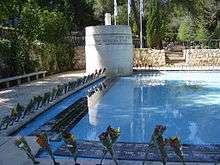SS Erinpura
 HS Erinpura | |
| History | |
|---|---|
| Name: | SS Eripura |
| Owner: | British-India Steam Navigation Company |
| Port of registry: |
|
| Builder: | William Denny and Brothers, Dumbarton |
| Yard number: | 945 |
| Launched: | 9 October 1911 |
| Completed: | 6 December 1911 |
| Fate: | Sunk by air attack on 1 May 1943 |
| General characteristics | |
| Class and type: | Passenger cargo vessel |
| Tonnage: | |
| Length: | 411 ft (125.27 m) |
| Beam: | 52 ft 6 in (16.00 m) |
| Draught: | 23 ft 5 in (7.14 m) |
| Installed power: |
|
| Propulsion: | Twin screws |
| Speed: | 16.7 knots (30.9 km/h) |
| Capacity: |
|
| Crew: |
|
SS Erinpura was a passenger liner built for the British-India Steam Navigation Company in 1911. She was the first British India ship built for Eastern service to be fitted with radio. She was sunk in the Mediterranean during World War II.
Construction and First World War
Erinpura was built by William Denny and Brothers, of Dumbarton and launched in 1911. She was one of seven sisters built at four different shipyards for the Bay of Bengal/Singapore Straits Service, the group which was one of the most successful, profitable and long lasting groups in the history of British India. She was used as a troopship early in the First World War, carrying troops from Karachi to Marseilles, and then to Sanniya in Iraq. She ran aground while sailing up the river to Abadan on 24 December 1914 and sustained some damage, but was able to return to Bombay. She made several more trooping voyages until becoming a hospital ship in August 1915, supporting the Indian Expeditionary Force with 475 beds and 104 medical staff. She served on the Basra-Bombay Service, and from November 1917 was used as an ambulance transport.
The ship was named after Erinpura, a village in Rajasthan.
Interwar
She ran aground again on 15 June 1919, this time on the Mushejera Reef in the Red Sea. Her passengers and troops were taken off by HMS Topaze and taken to Aden, but attempts to pull Erinpura off failed. It was eventually decided to cut the bow of the ship off, towing the stern to Aden, and leaving the bow stuck on the reef. A new bow was ordered from the original builders Dennys. The stern was towed to Bombay where the new bow section was fitted, and she returned to service in 1923.
Second World War
She was called up during the Munich Crisis in 1938, and was requisitioned for the Liner Division in March 1940. Erinpura was used as a troop transport in the Mediterranean, and in 1943 was the commodore's ship, under the command of Captain P.V. Cotter, in a Malta-bound convoy with three other British India ships, Karoa, Egra and Rohna, and twenty other merchantmen escorted by eleven warships. The convoy was attacked thirty miles north of Benghazi on 1 May 1943 by German bombers, with Erinpura being hit by a bomb in one of her holds. She sank within four minutes of being hit. Two junior engineers, 54 Indian seamen, three gunners, 140 Palestinian Jewish soldiers serving in 462 Transport Company of the British Army, and 600 Basuto pioneer troops were lost with her.
Memorial

There is a memorial on Mount Herzl to the 140 Jewish soldiers who drowned aboard the SS Erinpura. The monument is shaped like a ship containing a central pool, on the bottom of which are the names of the fallen. Above the pool is a turret adorned with the Hebrew text of Psalms 68:22: "The Lord said, I will bring again from Bashan, I will bring my people again from the depths of the sea." The day SS Erinpura sank according to the Hebrew calendar is on 26 Nisan a day before Yom HaShoah. The memorial ceremony is therefore held every year on Yom HaShoah. In addition, a ceremony is held every Yom Hazikaron by the Modi'in a Jerusalem chapter of the Hebrew Scouts Movement in Israel at the SS Erinpura monument, which is attended by the chapter graduates, families of fallen soldiers from Modi'in, and the general public.
References
- ss Erinpura
- The Troopships: 1902 to 1922
- THE ERINPURA: BASOTHO TRAGEDY
- SS Erinpura (+1943)
- S.S. Erinpura
- Sunk – Twice! Part 2 by Angela Ng
- List of shipwrecks in May 1943
Coordinates: 32°40′N 19°53′E / 32.667°N 19.883°E